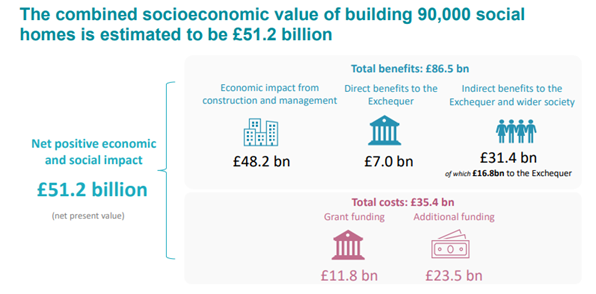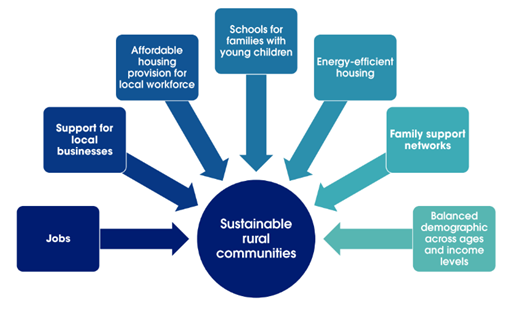T: 01822 851370 E: [email protected]
Visit RSN Survey about life in rural England to find out more.
Empowering Communities: Economic & Social Gains of Housing Initiatives

Swift Economic Boost
In recently published research by Shelter and the National Housing Federation, executed by the Centre for Economics and Business Research (CEBR), a compelling case is made for the economic and social benefits of constructing 90,000 social rented homes annually. This initiative, beyond addressing the dire need for affordable housing, promises a staggering £51.2bn addition to the economy, with effects felt almost immediately. Within a year, £32.6bn would be generated, supporting almost 140,000 jobs, showcasing the rapid impact on the economy and employment.
 |
Beyond the Build
This ambitious programme not only promises to break even within three years but also projects a £12bn profit for the taxpayer over 30 years. The ripple effects of such an investment extend beyond the immediate economic boost, paving the way for long-term benefits including substantial savings on housing benefits, a reduction in homelessness, enhanced employment opportunities, and notable improvements in healthcare outcomes.
The Social Value of Secure Homes
The societal benefits of providing stable, affordable housing are manifold. The research delineates a £31.4bn gain in societal benefits, encompassing higher employment, reduced benefit costs, improved healthcare, decreased homelessness, lowered crime rates, and better life chances for children. These benefits stress the transformative power of social housing on community well-being and economic stability.
The Case for Rural Affordable Homes
Research commissioned by the Rural Services Network, CPRE, and English Rural Housing in 2020 highlights the critical need for affordable homes in rural areas, especially in the wake of the pandemic. Building just ten new rural homes can inject £1.4 million into local economies, supporting jobs and generating significant government revenue. However, homelessness in rural England has alarmingly doubled in the last two years, with rural local authorities witnessing a significant increase. This surge points to a growing crisis in the countryside.
The Rural Services Network's forecast, envisioning a £1.4m economic boost and the support of 26 jobs for every ten new affordable homes built, stands as a testament to the economic and social imperatives of investing in rural affordable housing.
Investing in Housing for Growth and Health
Both bodies of research advocate for a substantial increase in the supply of affordable and social housing as a linchpin in driving post-pandemic recovery and addressing the chronic undersupply of housing. The economic rationale is clear: investing in housing is not just about providing roofs over heads but catalysing economic growth, enhancing public health, reducing welfare dependency, and fostering sustainable communities.
 |
A Unified Call for Action
As we move forward, the call to action is unequivocal. Both the government and the private sector must recognise the profound impact that investment in social and rural housing can have on our economy and society at large. By prioritising these initiatives, we can unlock a host of benefits that extend well beyond the construction phase, heralding a new era of prosperity and resilience for communities across the nation.
Resources
The Economic Impact of Building Social Housing - Full Report, Summary
Rural Recovery and Revitalisation – Full Report, Summary
In addition, Housing Insights on the RSN website has now been updated.
Analysis examining housing affordability which provides for the chosen authority the ratio of median house price to median gross annual workplace-based earnings and the ratio for the lower quartile situation similarly can be seen here.
Analysis presenting data on housebuilding, permanent dwellings started and completed, as a proportion of the total dwelling stock can be seen here. The analysis uses source data from the Ministry of Housing, Communities & Local Government and covers the period 2009/10 to 2022/23. Comparisons are provided for the class of authority selected and the rural classifications.



